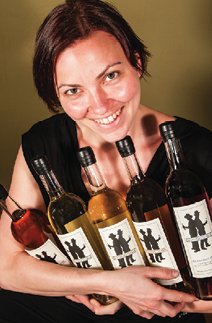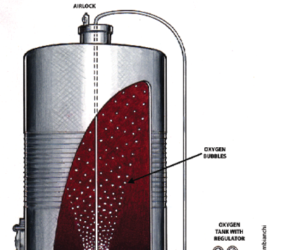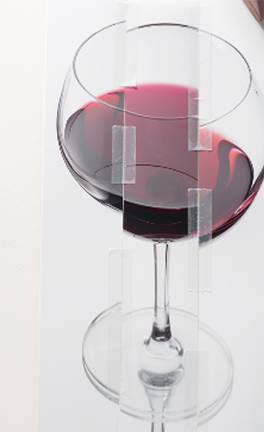Meadmaking — like winemaking — has been around for thousands of years. And if you make wine you can also make mead using much of the same equipment. In this issue, two master meadmakers share some insight for making your own mead at home.
 Michael Fairbrother, Founder and Meadmaker of Moonlight Meadery in Londonderry, New Hampshire. Michael has homebrewed since 1995. Started in his garage in 2010, Moonlight Meadery now has capacity to produce over 200,000 bottles per year.
Michael Fairbrother, Founder and Meadmaker of Moonlight Meadery in Londonderry, New Hampshire. Michael has homebrewed since 1995. Started in his garage in 2010, Moonlight Meadery now has capacity to produce over 200,000 bottles per year.
We make more than 58 different varieties of mead at Moonlight Meadery — everything from traditional meads to melomels to metheglins. I choose to make all of these different varieties because I like the diversity. Within the traditional mead category, we also make many different types of meads using different types of honey. The great thing about mead is that you can ferment year-round. I also think I have more of an ability to make unique flavors than traditional wineries. You can make a very well-balanced mead that can go with anything.
I usually work with wildflower blossom honey for our meads, but I do also work with other types of honey such as Tupelo, cranberry, blueberry blossom and orange blossom varieties. I would have to say that my favorite variety of honey is Tupelo, which is produced from the White Ogeechee Tupelo, but it is very hard to come by as it is only produced in the Northwest region of Florida that includes the Ogeechee River, the Apalachicola, and the Chattahoochee River basins. So when I can’t get Tupelo, my second favorite honey variety is orange blossom. It’s all a matter of personal preference. For example, my mother’s favorite variety is almond blossom. We tend to use the specialty honey varieties only for traditional meads as it will showcase the honey’s flavor, and use more neutral honey for fruit meads. We do, however, make our strawberry rhubarb mead with orange blossom honey because it softens up the tartness from the rhubarb and also gives it a nice balance.
If you want to make mead at home I would recommend always using yeast nutrients. At Moonlight we use a staggered yeast nutrient program: split the nutrients — half and half of GoFerm and Fermaid K. For example, in a 5-gallon (19-L) batch I would recommend 1.5 tsp. of Fermaid K and 1.5 tsp. of GoFerm (or you can use diammonium phosphate /DAP). Add a fourth of this mixture for the first three days (1⁄4 each day). When 30% of the sugar is depleted add therest of the mixture. This gives the yeast the right amount of nutrients as it is growing and multiplying and really helps
prevent the fusel alcohols by controlling the temperature.
As for yeast, we only use one strain, Lalvin 71B, which is a white wine yeast. I like using it for our meads because I think it has a nice neutral palate, and it also likes to ferment at a low temperature — around 62 °F (17 °C). When kept at that temperature 71B can give the mead a nice, clean flavor.
One of the things I would caution anyone to be careful about when making mead at home is to be careful to get honey from a really good source. You don’t want to use honey that is cheap — the results can be disastrous.
My other advice for any amateur meadmakers is to make a lot of it. In order to really understand how to make mead you need to practice. One year I made 60 different batches of mead, which were all a 1⁄2-gallon (1.9-L) each to try making different types.
Also, don’t be afraid to experiment with your homemade meads. We recently barrel-aged some of our mead with oak barrels we got from Sam Adams (Boston Beer Company), and I think that the oaking takes the mead to a whole new level.
 Candy Griffin, Meadmaker at Brothers Drake Meadery in Columbus, Ohio. A love of craft wine, beer and spirits spurred Candy’s desire to learn the science and artistry of making mead.
Candy Griffin, Meadmaker at Brothers Drake Meadery in Columbus, Ohio. A love of craft wine, beer and spirits spurred Candy’s desire to learn the science and artistry of making mead.
We make about 10 different flavors of mead. Traditionals, melomels, metheglins, and a cyser. They range from dry to sweet.
Honey is sort of the terroir of the mead world. The flavor of the honey comes from the flowers the bees harvested, so honeys vary both seasonally and regionally depending on what blossoms are out. We use all local Ohio wildflower honey. Our beekeeper lives locally and all of his hives are within about an hour of the meadery.
I use wine yeasts to ferment our meads, and I use different strains for different meads. I rehydrate our yeast with GoFerm then introduce the yeast slowly into a small amount of must to get it active before mixing it into the batch.
Much of the meadmaking process is the same as wine. We are always fighting oxidation and spoilage. We keep a layer of CO2 on all of our meads in tanks, and we are extremely sanitary to fight off any spoilage microorganisms. We use bentonite and depth filtration to remove yeasts and bacteria, and potassium sorbate to stabilize post-filtration. We do not use sulfites, so we are extra, extra careful about preserving our meads.
When making a melomel, the higher quality ingredients you use, the better your final product will taste. Use quality, local fruits. Most melomels tend to rise up quite high at the beginning of fermentation as well, so leave room in your fermenter.
My advice is to have fun with it if you make mead. Mead is so versatile; you can make so many different varieties. Herbs, fruits, squashes, dry, sweet, spicy, sparkling, still — the possibilities really are endless. I recently made a burnt mead at home. I boiled the honey for two hours and my house still smells like caramelized honey. I can’t wait to see how it tastes after fermentation.
 Michael Fairbrother, Founder and Meadmaker of Moonlight Meadery in Londonderry, New Hampshire. Michael has homebrewed since 1995. Started in his garage in 2010, Moonlight Meadery now has capacity to produce over 200,000 bottles per year.
Michael Fairbrother, Founder and Meadmaker of Moonlight Meadery in Londonderry, New Hampshire. Michael has homebrewed since 1995. Started in his garage in 2010, Moonlight Meadery now has capacity to produce over 200,000 bottles per year.
 Candy Griffin, Meadmaker at Brothers Drake Meadery in Columbus, Ohio. A love of craft wine, beer and spirits spurred Candy’s desire to learn the science and artistry of making mead.
Candy Griffin, Meadmaker at Brothers Drake Meadery in Columbus, Ohio. A love of craft wine, beer and spirits spurred Candy’s desire to learn the science and artistry of making mead.





